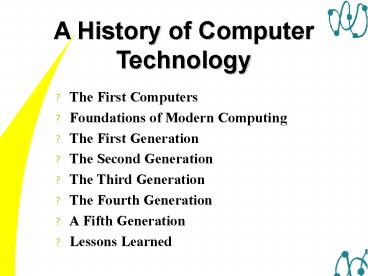The First Computers - PowerPoint PPT Presentation
Title:
The First Computers
Description:
Apple Computer founded. IBM introduced the Personal Computer (PC) ... Apple Computer. IBM. Macintosh was the first commercial personal computer to offer a user ... – PowerPoint PPT presentation
Number of Views:1786
Avg rating:3.0/5.0
Title: The First Computers
1
A History of Computer Technology
- The First Computers
- Foundations of Modern Computing
- The First Generation
- The Second Generation
- The Third Generation
- The Fourth Generation
- A Fifth Generation
- Lessons Learned
2
The First Computers
A Historical Perspective
The abacus, known to have existed in ancient
Babylonia and Egypt, remained in widespread use
in the Far East until recently.
3
The First Computers
A Historical Perspective
- Jacquards Loom programmed a loom
- Babbages Folly first fully modern computer
design - Difference Engine
- Analytical Engine
4
The First Computers
A Historical Perspective
Augusta Ada Byron, the worlds first computer
programmer, played a key role in formulating the
notion of programming the Analytical Engine.
5
The First Computers
A Historical Perspective
In 1991, the London Science Museum built the
Difference Engine using Babbage's plans, as shown
in this woodcut. It worked perfectly.
6
The First Computers
A Historical Perspective
- Hollerith the Automated Census Bureau
- invented an electronic punching device
- founded Tabulating Machine Co. which became IBM
Holleriths punched-card tabulating machines are
the predecessors of todays business machines.
7
Foundations of Modern Computing
A Historical Perspective
ENIAC, created by Dr. John Mauchly J. Presper
Eckert, for use in the war but was not completed
in time. It was mainly used to solve math
problems
8
The Stored Program Concept
A Historical Perspective
The computer program, as well as the data, is
stored in the computers memory.
9
The First Generation1950s
A Historical Perspective
The first generation of computers used vacuum
tubes. Vacuum tubes failed frequently so first
generation computers did not work most of the
time.
10
A Historical Perspective
Eckert and Mauchly delivered the first UNIVAC to
the U.S. Census Bureau in 1951. UNIVAC gained
fame when it predicted Eisenhower as the winner
of the 1952 U.S. presidential election.
11
The First Generation
A Historical Perspective
- Features of UNIVAC
- easier to use (than ENIAC)
- fewer vacuum tubes (more reliable)
- stored program
- general-purpose
- used machine language
- IBM 701
- IBM 650
12
The Second GenerationEarly1960s
A Historical Perspective
The transistor heralded the second generation of
computers
13
The Second Generation
A Historical Perspective
- Features and Advancements
- still use punch cards
- used printers, tape storage, disk storage
- used high-level programming languages
- COBOL FORTRAN introduced
- IBM 1401
14
The Second Generation
A Historical Perspective
- Electronic Recording Machine -- Accounting (ERMA)
- American Standard Code for Information
Interchange (ASCII) - IBM System/360
- line of compatible computers
- instruction set enabled to be used for both
business and science
15
The Third Generation(Mid 1960s to Mid 1970s)
A Historical Perspective
- Advancements and Milestones
- used timesharing
- accessed remotely by terminals
- used integrated circuits (small, medium, to
large-scale integration) resulting in lower cost
Integrated chips
16
The Third Generation
A Historical Perspective
- More Advancements and Milestones
- DECs minicomputer, the PDP-8
- many different programming languages
- IBM unbundled its systems
17
A Historical Perspective
- Still More Advancements and Milestones
- Wide-area networks (WAN) developed
- ARPANET implemented Internet protocols (TCPIP)
- Local area networks (LAN) developed
- Mainframes (proprietary)/minicomputers (open
architecture)
18
The Fourth Generation(1975-1991)
A Historical Perspective
- Advancements and Milestones
- employed very-large-scale integration (VLSI)
- developed Intel 4004, first microprocessor
- Apple Computer founded
- IBM introduced the Personal Computer (PC)
- IBM compatibles or clones introduced
19
The Fourth Generation
A Historical Perspective
The first IBM PC was released in 1981. Intel
provided the microprocessor chip and Microsoft
Corporation provided the operating system
20
The Fourth Generation
A Historical Perspective
IBM
Apple Computer
Interfaces
Intel
Motorola
PC
Macintosh
The first GUI was developed at Xerox
Corporations Palo Alto Research Center (PARC)
21
A Historical Perspective
IBM
Apple Computer
Microsofts Windows 98 is a popular GUI designed
for IBM-compatible microcomputers
Macintosh was the first commercial personal
computer to offer a user interface
22
A Fifth Generation?
A Historical Perspective
Experts have forecast that the hallmark of the
fifth generation will be artificial intelligence
(AI), in which computers exhibit characteristics
of human intelligence. AI has been slow in coming.
23
A Fifth Generation?
A Historical Perspective
Technologically, were still in the fourth
generation, in which engineers are pushing to see
how many transistors they can pack on chip. This
effort alone will bring some of the trappings of
AI.
24
Lessons Learned
A Historical Perspective
- Purposes served by technologies cannot be
foreseen by designers - Developing faster hardware is easier than
developing good software - A company is wise to create products that conform
to published, non-proprietary standards































